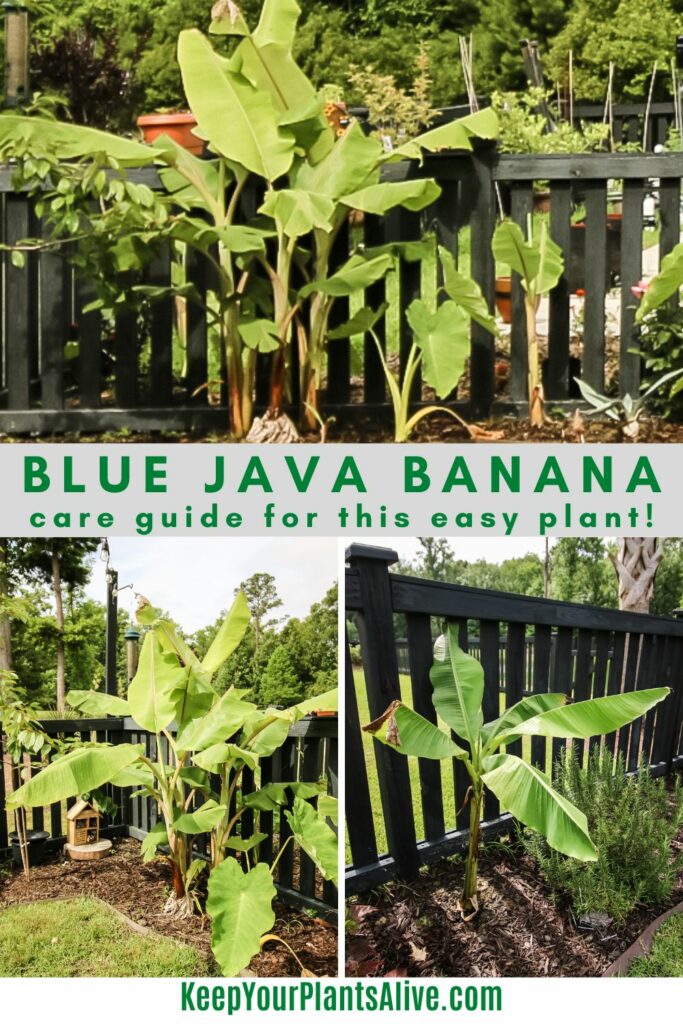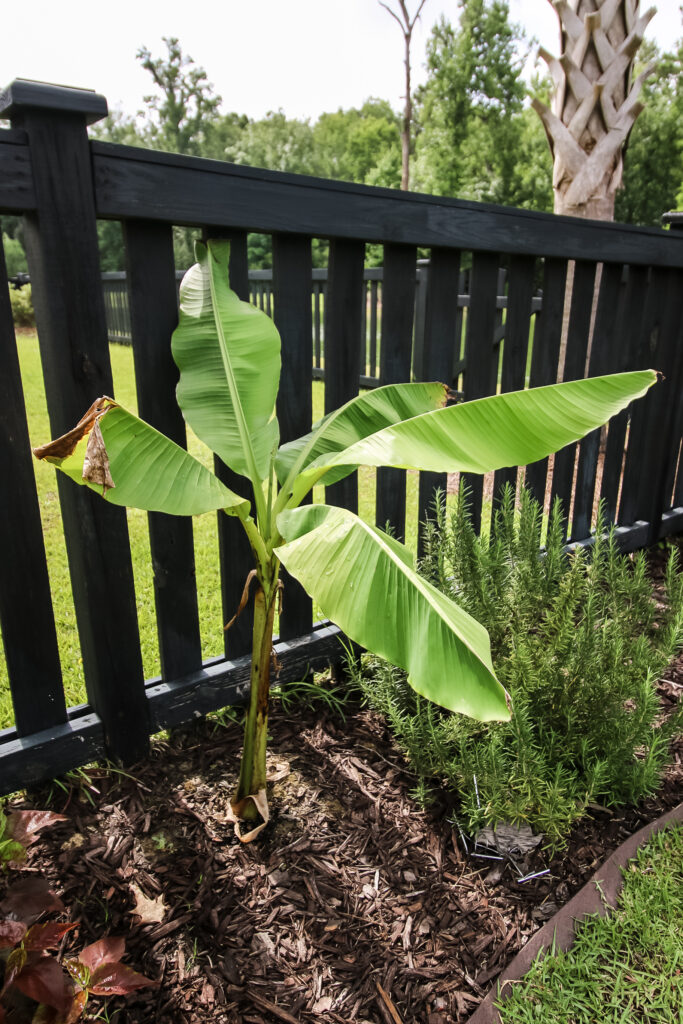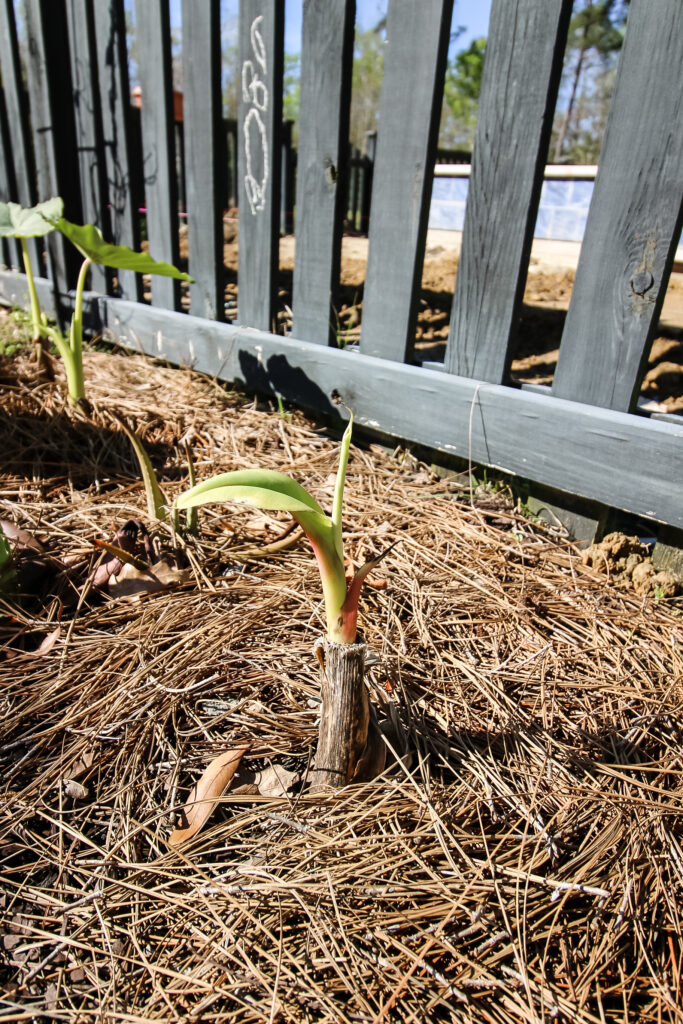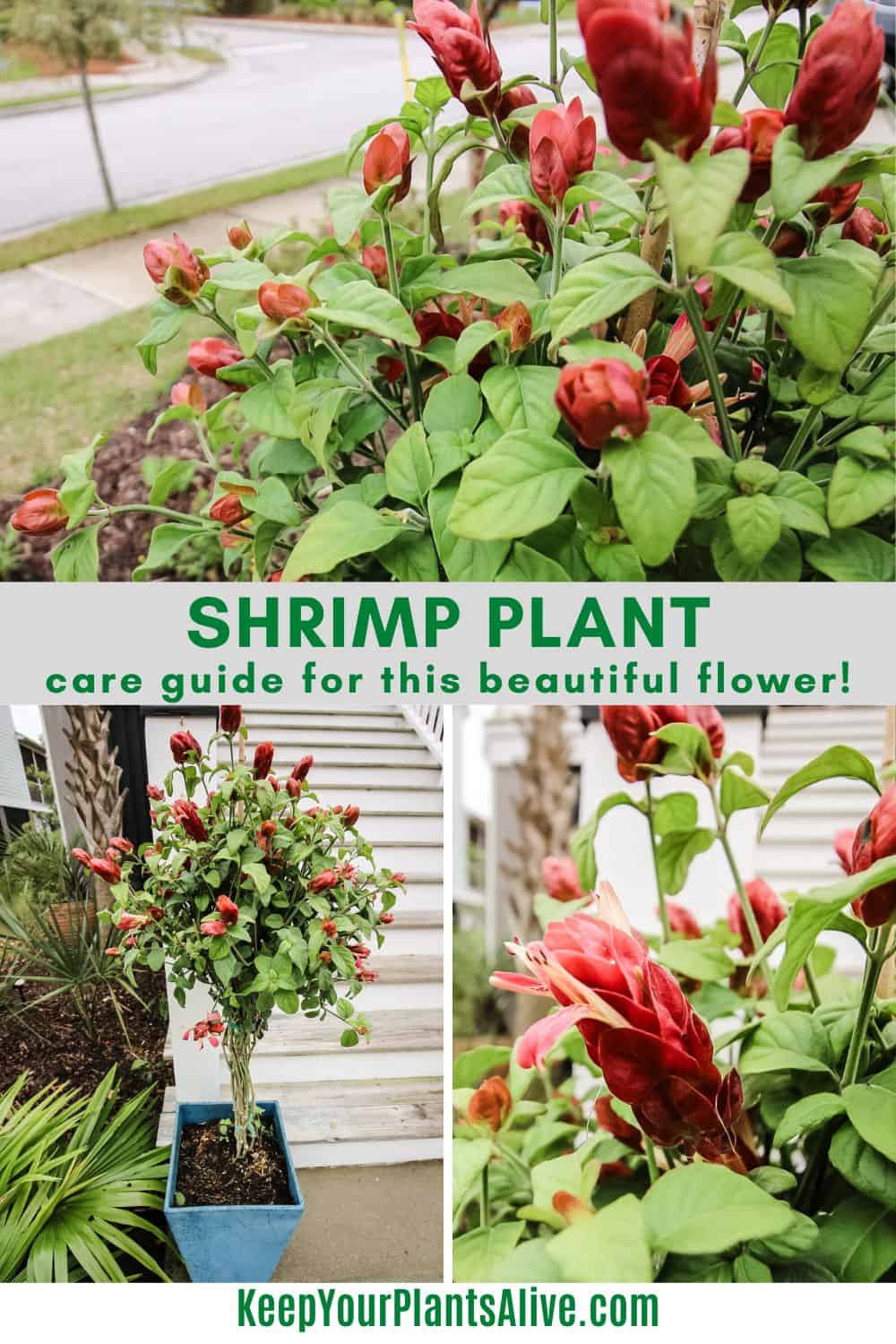Want to add a unique banana tree to your yard? Here is my complete blue java ice cream banana tree care guide!
Last summer, a neighbor posted on Facebook that they were giving away pups from their Blue Java banana tree. (he originally got his on Etsy, here!)
I was quick to respond and pick them up and went on to get several more pups from him throughout the summer.
We now have a nice line of these banana trees along our fence line, and I absolutely love how they look!
In this blog post, we will delve into the captivating world of the Blue Java Ice Cream Banana Tree, a tropical beauty known for its deliciously sweet and creamy fruit.
Whether you're a seasoned gardener or just starting your plant journey, this care guide will provide you with all the essential tips and tricks to nurture your Blue Java Ice Cream Banana Tree and enjoy its delicious treats in no time.

Blue Java Ice Cream Banana Tree
Let's dive into everything you might want to know about the ice cream banana tree.
Description and Origin
The Blue Java Ice Cream Banana Tree is a visually striking and unique addition to any garden.
Its appearance is characterized by large, lush leaves that have a distinctive blue-green hue, setting it apart from other banana tree varieties.
The leaves have a slightly waxy texture, giving them a glossy look. You can't beat the tropical vibes of banana leaves!
Originating from Southeast Asia, particularly regions like the Philippines, Indonesia, and Malaysia, the Blue Java Ice Cream Banana Tree thrives in tropical climates.
It is well-adapted to warm and humid conditions, which is why it flourishes in countries with such climates.
The tree's origin in Southeast Asia is reflected in its common names, such as "Ice Cream Banana" or "Blue Java Banana," highlighting the fact that the fruit has the texture and flavor of ice cream.

Planting Considerations
The Blue Java Ice Cream Banana Tree thrives in specific conditions, including temperature, sunlight, and soil requirements. Here are the ideal conditions for successfully growing this tree:
Temperature
The Blue Java Ice Cream Banana Tree flourishes in warm tropical and subtropical climates. It prefers temperatures between 75°F and 95°F (24°C and 35°C) during the day and around 60°F to 70°F (15°C to 21°C) at night.
It is important to protect the tree from temperatures below 50°F (10°C) as it is sensitive to frost.
Sunlight
This tree loves basking in the sun. It requires a minimum of 6 to 8 hours of direct sunlight per day to thrive.
Plant it in a location that receives ample sunlight, such as a spot in your garden that isn't shaded by buildings or large trees.
Soil
The Blue Java Ice Cream Banana Tree thrives in well-draining soil that retains moisture without becoming waterlogged.
The ideal soil pH ranges between 5.5 and 7.0. It benefits from rich, fertile soil that is high in organic matter.
You can improve the soil's fertility by adding compost or well-rotted manure before planting.
Adaptability
The Blue Java Ice Cream Banana Tree is versatile and can be grown both in garden beds and containers.
In garden beds, make sure the soil is well-prepared, and there is enough space for the tree to spread its roots.
In containers, choose a large pot with good drainage holes and use a well-draining potting mix.
Growing in containers allows for flexibility in moving the tree indoors during colder seasons in non-tropical regions.
Whether you choose to plant the Blue Java Ice Cream Banana Tree in a garden bed or a container, providing the right conditions in terms of temperature, sunlight, and soil will set the stage for its successful growth and fruit production.

Selecting a Location
Choosing the right spot for your Blue Java Ice Cream Banana Tree is crucial for its overall health and productivity. Here are some factors to consider when selecting a suitable location:
Sunlight
Aim for a spot that receives full sun to partial shade, ensuring your tree gets at least 6 to 8 hours of direct sunlight each day.
Avoid areas shaded by buildings, tall trees, or other structures that may obstruct sunlight and limit the tree's growth.
Wind Exposure
While the Blue Java Ice Cream Banana Tree can tolerate gentle breezes, strong winds can damage its large leaves and hinder growth.
Our banana trees really get torn up during tropical storm season! Luckily, they are fine with tattered leaves - its purely aesthetic.
Plant the tree in a location shielded from strong winds, such as near a fence or wall.
If your garden is consistently windy, consider creating a windbreak using hedges, screens, or other protective structures.
Frost Protection
The Blue Java Ice Cream Banana Tree is sensitive to frost and requires protection in regions with colder climates.
Choose a spot that offers natural frost protection, such as near a south-facing wall that absorbs and radiates heat.
In colder regions, consider planting the tree in a container so you can easily move it indoors during winter or cover it with frost blankets during frosty nights.
Space
Ensure that the chosen spot provides enough space for the tree to grow and spread its large leaves.
The Blue Java Ice Cream Banana Tree can reach a height of 15 to 20 feet and has a spread of 8 to 10 feet, so plan accordingly.
Leave sufficient distance from buildings, other plants, or structures to allow for proper airflow and prevent overcrowding.
By considering these factors, you can find the perfect spot for your Blue Java Ice Cream Banana Tree, maximizing its exposure to sunlight, protecting it from strong winds, and ensuring it stays safe from frost in colder climates.

Soil Preparation
Well-draining soil and the incorporation of organic matter are essential for the successful growth and health of your Blue Java Ice Cream Banana Tree.
Here's why they are important and some suitable soil mix or amendments for optimal growth:
Importance of well-draining soil
Prevents water-logging: Well-draining soil allows excess water to drain away, preventing the roots from sitting in waterlogged conditions. This helps prevent root rot and other moisture-related issues.
Enhances aeration: Proper drainage ensures that there is enough air circulation in the root zone, which is crucial for root health and nutrient uptake.
Reduces the risk of fungal diseases: Excess moisture in poorly draining soil can promote the growth of fungi and increase the risk of diseases that can harm the roots and overall plant health.
Incorporation of organic matter:
Improves soil structure: Organic matter, such as compost or well-rotted manure, improves soil structure by promoting better water retention and drainage. It enhances the soil's ability to hold onto moisture without becoming waterlogged.
Provides essential nutrients: Organic matter is rich in nutrients and serves as a slow-release fertilizer for the plant. It improves soil fertility, supplying the necessary nutrients for the Blue Java Ice Cream Banana Tree's growth and fruit production.
Enhances microbial activity: Organic matter acts as a food source for beneficial soil microorganisms, fostering a healthy soil ecosystem that aids in nutrient cycling and overall plant health.
Suitable soil mix or amendments
Well-draining soil mix: Prepare a soil mix that consists of equal parts of well-draining garden soil, compost, and perlite or coarse sand. This mix ensures good drainage while providing nutrients and organic matter for the tree's growth.
Organic amendments: Incorporate compost or well-rotted manure into the soil mix before planting. These amendments improve soil structure, add nutrients, and enhance moisture retention.
Mulching: Apply a layer of organic mulch, such as straw or wood chips, around the base of the tree. Mulching helps retain soil moisture, regulates soil temperature, and suppresses weed growth.
Remember to periodically check the soil moisture and adjust watering accordingly, as well-draining soil also requires regular irrigation to maintain proper moisture levels for the Blue Java Ice Cream Banana Tree.

Propagation Methods
One cool thing about banana plants is that they are self-multiplying. These plants put up babies - called pups - like wildfire during the summer! The pups can be split off and separated or left to cluster with the parent plant.
Here's a step-by-step guide on propagating Blue Java Ice Cream Banana Trees through suckers or offshoots:
- Identify a healthy sucker or offshoot: Look for a strong, young sucker or offshoot growing near the base of the parent plant. It should have its own set of leaves and roots beginning to form.
- Prepare the propagation site: Choose a location in your garden or prepare a container with well-draining soil mix. Ensure the spot receives adequate sunlight and has suitable temperature conditions for the growth of the young plant.
- Prepare the sucker or offshoot for separation:
- Use a sharp, sterile knife or pruning shears to cut the sucker or offshoot close to the base of the parent plant. Ensure that it has a section of rhizome (underground stem) attached.
- Remove any excess leaves or side shoots, leaving a few healthy leaves at the top to support photosynthesis.
- Planting the sucker or offshoot:
- Dig a hole in the prepared soil or container that is deep enough to accommodate the roots of the sucker or offshoot.
- Place the plant in the hole, ensuring that the rhizome is at the same depth as it was in the parent plant.
- Backfill the hole with soil, gently firming it around the roots to eliminate air pockets.
- Watering and care:
- Water the newly planted sucker or offshoot thoroughly, ensuring that the soil is evenly moist but not waterlogged.
- Keep the plant well-watered in the following weeks to promote root establishment and growth.
- Provide regular care, including appropriate fertilization, protection from harsh weather conditions, and weed control.

Watering and Feeding
Banana plants in general love to be fertilized and like a lot of water!
Watering Guidelines
During the growing season (spring and summer): Water the tree deeply and thoroughly once or twice a week, depending on the weather conditions and soil moisture levels.
In hot and dry climates: Water more frequently, ensuring that the soil remains evenly moist. Monitor the soil moisture to avoid drying out.
Checking soil moisture: Before watering, check the soil moisture by inserting your finger into the soil up to a few inches. If it feels dry, it's time to water. If it feels moist, wait for a day or two before checking again.
Avoid overwatering, as excessive moisture can lead to root rot and other fungal diseases.
Water the Blue Java Ice Cream Banana Tree deeply, allowing the water to penetrate the soil around the root zone.
Apply water slowly and evenly, ensuring that it reaches the deeper roots. This encourages the development of a strong and extensive root system.
Mulching
Apply a layer of organic mulch, such as straw or wood chips, around the base of the tree.
Mulching helps retain soil moisture, reducing the frequency of watering while providing insulation for the roots.
Humidity requirements
The Blue Java Ice Cream Banana Tree thrives in humid environments, and maintaining proper humidity levels is beneficial for its growth and overall health. Here's why humidity is significant for the tree:
- Leaf health: Adequate humidity prevents the leaves from drying out, reducing the risk of leaf browning or curling.
- Transpiration: Proper humidity allows for optimal transpiration, which is the process of water movement through the plant. It helps the tree absorb nutrients and stay hydrated.
- Moisture retention: Higher humidity levels around the plant help to retain moisture in the soil for longer periods, reducing the need for frequent watering.
Fertilization
Regular feeding and proper fertilization are crucial for promoting healthy growth and optimal nutrition for the Blue Java Ice Cream Banana Tree. Fertilization is important for:
- Nutrient availability: Regular feeding ensures that the Blue Java Ice Cream Banana Tree has access to essential nutrients necessary for its growth, fruit production, and overall health.
- Soil fertility maintenance: Continuous nutrient replenishment helps maintain soil fertility, especially in cases where the tree is grown in containers or in gardens with nutrient-depleted soil.
- Vigorous growth: Adequate nutrition supports the tree's vigor, promoting robust foliage development, strong root growth, and increased resistance to pests and diseases.
Suitable fertilizer types
- Balanced slow-release fertilizer: Look for a balanced granular fertilizer with an N-P-K (nitrogen-phosphorus-potassium) ratio of 14-14-14 or 10-10-10. These provide a good mix of essential nutrients for overall plant health.
- Organic options: Consider using organic fertilizers such as compost, well-rotted manure, or organic plant-based fertilizers. These options contribute to soil health, enhance microbial activity, and provide a gradual release of nutrients.
Fertilization frequency and application methods
First year: During the first year of planting, apply a slow-release balanced fertilizer in early spring when the tree begins active growth. Follow the package instructions for the recommended application rates.
Subsequent years: From the second year onward, apply fertilizer three times a year for optimal growth and fruit production:
Early spring: Apply a slow-release balanced fertilizer around the drip line of the tree, following the package instructions for the recommended quantity.
Mid-summer: Apply a water-soluble or liquid fertilizer high in potassium to promote fruiting and flowering. Dilute the fertilizer according to the package instructions and apply around the base of the tree.
Early fall: Apply a slow-release or organic fertilizer to help prepare the tree for the following season's growth. Follow the package instructions for the recommended quantity.
Sprinkle the granular fertilizer evenly on the soil surface around the tree, avoiding direct contact with the trunk. Gently incorporate the fertilizer into the topsoil using a rake or by watering it in.
For water-soluble or liquid fertilizers, dilute the product according to the package instructions. Apply the solution directly to the soil around the tree's base, ensuring even coverage.
Remember to water the tree thoroughly after applying fertilizers to prevent any potential root burn and to aid in nutrient absorption.
By following a regular feeding schedule and using suitable fertilizers, you can provide the Blue Java Ice Cream Banana Tree with the necessary nutrients for healthy growth, robust foliage, and abundant fruit production.

Pruning and Maintenance
These are pretty easy care plants that grow like weeds once they get growing. They just need a little pruning and to watch out for pests or diseases.
Pruning Techniques
Pruning plays a significant role in maintaining the overall health, appearance, and productivity of the Blue Java Ice Cream Banana Tree.
Dead or damaged leaves: Pruning allows for the removal of dead or damaged leaves, which helps improve the tree's aesthetics and prevents potential diseases or pests from spreading to healthy parts of the plant.
Excess growth management: Pruning helps control and thin out excessive foliage, enabling better air circulation and reducing the risk of fungal diseases. It also prevents overcrowding, allowing light to reach the inner parts of the tree.
Sucker management: Pruning is essential for managing suckers or offshoots, ensuring the main plant's energy is directed towards fruit production rather than the growth of unwanted shoots.
Here are the general steps you should take when pruning your banana tree:
Removing dead or damaged leaves
Regularly inspect the tree for any dead or damaged leaves.
Using clean and sharp pruning shears, carefully cut off the affected leaves as close to the base as possible.
Dispose of the removed leaves to prevent the spread of diseases.
Thinning out excess growth
Identify areas of dense foliage or overcrowding within the tree.
Select the weaker or overcrowded stems/branches and use pruning shears to remove them completely at their base.
Aim to create an open and balanced canopy that allows light to reach all parts of the tree.
Managing suckers
Monitor the base of the tree for the emergence of suckers or offshoots.
Identify the strongest and healthiest sucker(s) that you want to keep as potential replacements or for propagation.
Carefully remove the unwanted suckers by cutting them as close to the base as possible.
If desired, you can propagate the removed suckers by following the earlier discussed propagation steps.
Tips for pruning:
- Use clean and sharp pruning shears to make clean cuts, minimizing the risk of introducing infections or damaging the tree.
- Prune during the active growing season when the tree is in its most vigorous state.
- Avoid excessive pruning, as it can reduce fruit production. Aim to strike a balance between maintaining a healthy shape and preserving the tree's ability to bear fruit.

Pests and Diseases
The Blue Java Ice Cream Banana Tree can be susceptible to certain pests and diseases.
Banana aphids
These small, soft-bodied insects feed on the sap of the plant, causing stunted growth and distortion of leaves.
Preventative measures:
- Regularly inspect the tree for aphids and other pests.
- Encourage natural predators like ladybugs and lacewings. Organic remedies:
- Spray a mixture of diluted neem oil or insecticidal soap on affected areas.
- Introduce beneficial insects such as ladybugs or release parasitic wasps.
Banana weevils
These insects attack the base of the plant, causing damage to the roots and weakening the tree's stability.
Preventative measures:
- Inspect new plants for signs of weevil infestation before bringing them into your garden.
- Avoid planting in soil with a history of weevil infestation. Organic remedies:
- Remove and destroy infected plants.
- Apply beneficial nematodes to the soil to control weevil larvae.
Panama disease (Fusarium wilt)
A soil-borne fungal disease that causes wilting, yellowing of leaves, and eventual plant death.
Preventative measures:
- Plant disease-resistant varieties.
- Rotate crops to prevent the buildup of pathogens in the soil. Organic remedies:
- Unfortunately, there are no effective organic remedies once the tree is infected. Remove and destroy infected plants to prevent the spread to healthy ones.
Leaf spot diseases
Various fungal or bacterial infections can cause dark spots or lesions on leaves, affecting overall plant health.
Preventative measures:
- Avoid overhead watering and promote good air circulation.
- Remove and dispose of infected leaves promptly. Organic remedies:
- Apply a copper-based fungicide according to the manufacturer's instructions.
- Use a homemade spray made from a mixture of baking soda, water, and a few drops of dish soap as a preventive measure.
It's important to note that prevention is key in managing pests and diseases. Here are additional general preventative measures:
- Practice good sanitation by removing fallen leaves and debris around the tree.
- Avoid overwatering, as excess moisture can create favorable conditions for diseases.
- Ensure proper spacing between plants to allow for good air circulation.
- Maintain overall plant health through proper watering, fertilization, and pruning.
If you encounter severe pest or disease issues, consider consulting with a local horticulturist or extension service to get specific advice and recommendations based on your region and the severity of the problem.

Harvesting and Enjoying the Fruits
It will take 2-3 years for your Blue Java banana tree to actually grow bananas. Once your plants get bananas on them, it's time to harvest!
Fruit Maturation
Flowering stage:
This stage occurs when the tree produces inflorescence, commonly referred to as a banana flower or bud.
The banana flower consists of overlapping bracts that enclose individual clusters of flowers, known as hands.
The hands are composed of numerous individual flowers, called fingers.
Pollination and fruit set stage:
During this stage, the flowers need to be pollinated to set fruit.
In the Blue Java Ice Cream Banana Tree, the flowers are self-fertile, meaning they can self-pollinate without requiring assistance from pollinators.
Pollination can occur when the flowers are exposed to wind or gentle shaking.
Fruit development stage:
After successful pollination, the flowers transform into small, green fruits.
The fruits gradually enlarge and elongate as they develop.
During this stage, it is crucial to provide adequate sunlight, water, and nutrients to support healthy fruit growth.
Ripening stage:
The fruits undergo a ripening process, during which they change color and develop the desired flavor and texture.
In the Blue Java Ice Cream Banana Tree, the fruits turn from green to a distinctive blue-green color when fully ripe.
The exact duration of the ripening stage can vary, but it typically takes several weeks from the onset of ripening until the fruits are ready for harvest.
Approximate timeline from flowering to harvest:
- Flowering: The flowering stage can last for several weeks, depending on various factors such as environmental conditions and the health of the tree.
- Pollination and fruit set: Pollination usually occurs within a week or two after flowering.
- Fruit development: The duration of fruit development can vary, but it generally takes around 70 to 100 days from pollination to reach maturity, depending on the specific cultivar and growing conditions.
- Ripening: Once the fruits start ripening, it can take approximately 2 to 4 weeks until they are fully mature and ready for harvest.
Harvesting Tips
Identifying ripe fruit on the Blue Java Ice Cream Banana Tree involves observing certain visual cues and assessing the ease of separation from the tree. Here's how to identify ripe fruit:
Color changes
The Blue Java Ice Cream Banana fruit undergoes a distinct color transformation as it ripens.
When the fruit is fully mature and ready to be harvested, it develops a unique blue-green color.
Size and shape
Ripe Blue Java Ice Cream Bananas typically have a plump and elongated shape.
Ease of separation from the tree
Gently grasp the fruit and try to tilt it horizontally. Ripe fruits will naturally separate from the tree with minimal effort.
Avoid forcefully pulling or twisting the fruit, as it may cause damage to the tree or unripe fruit.
Recommendations for the best time of day to harvest:
- Morning or early afternoon is generally considered the ideal time to harvest Blue Java Ice Cream Bananas for optimal flavor.
- Harvesting during these times allows the fruit to benefit from the natural sugars and flavors that have accumulated throughout the day.
- It's important to avoid harvesting during hot midday temperatures, as this can cause the fruit to become overly soft or mushy.
Remember, taste preferences may vary, so you can experiment with different harvest times to find the flavor and texture that you prefer.
Regularly check the fruit for ripeness using the color changes and ease of separation as indicators, and adjust your harvest timing accordingly.
Enjoy the delicious flavor of your freshly harvested Blue Java Ice Cream Bananas!
Blue Java Banana Tree FAQs
The Blue Java Ice Cream Banana Tree can reach an average height of 15 to 20 feet, making it a moderately sized tree.
Yes, the Blue Java Ice Cream Banana Tree thrives in full sun to partial shade, requiring at least 6 hours of direct sunlight each day for optimal growth.
While it's challenging to grow the tree indoors due to its size and light requirements, you can grow it in a large container and place it near a sunny window. However, outdoors is generally recommended.
On average, the Blue Java Ice Cream Banana Tree takes around 2 to 3 years to produce its first fruits, but it may vary depending on growing conditions and care.
Yellowing leaves can indicate overwatering, nutrient deficiencies, or other issues. Check the soil moisture, adjust watering accordingly, and consider fertilizing with a balanced fertilizer.
While the tree is relatively resilient, it can still be susceptible to pests like aphids and diseases like Panama disease. Regular monitoring, good sanitation practices, and organic pest control methods can help prevent and manage such issues.
Fertilize your tree every 4 to 6 weeks during the growing season, using a balanced slow-release fertilizer or a potassium-rich fertilizer specifically formulated for bananas.
Yes, growing multiple trees in close proximity can aid in cross-pollination and increase fruit production. Maintain a spacing of around 10 to 12 feet between trees for optimal growth.
When frost is expected, cover the tree with frost blankets or use a protective structure, such as a cold frame or greenhouse. Providing a layer of mulch around the base can also help insulate the roots.
The Blue Java Ice Cream Banana Tree thrives in USDA hardiness zones 9 to 11. However, in colder climates, you can try growing in containers and bring the tree indoors during winter or provide additional protection against frost.
Any more questions about Ice Cream banana trees?
Thanks for reading!


Hey there, I'm Morgan, a houseplant enthusiast from sunny Charleston, South Carolina. Growing up surrounded by my mom's lush orchids and African violets, I discovered the magic of bringing nature indoors. Thanks to the pandemic, I delved deeper into houseplants, discovering their power to uplift moods and transform spaces. I'm here to spill all my secrets, helping you pick the perfect houseplant - and make it happy. Let's keep your plants alive, together! 😊




